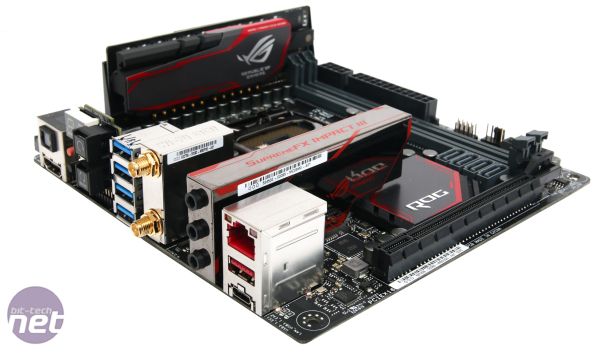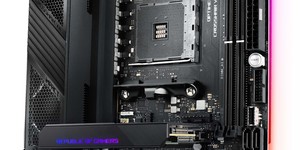
Performance Analysis
One thing stood out from the stock speed numbers and that's that the Impact isn't great out of the box, at least with our setup and the BIOS we tested with. It was near bottom or bottom of most of the graphs through image editing, rendering and even gaming. Even the SATA 6Gbps speeds were a tad slow using our standard version of CrystalDiskMark but we should point out that on further investigation, the latest version of the software did show 560MB/sec read and 522MB/sec write speeds respectively - pretty much as fast as our Samsung 850 Pro will go. There's clearly some issue here with the Impact and our usual version of CrystalDiskMark that we're using for comparison with past results, but we'll be updating to the new version soon. For now, we'll say don't read too much into these slower numbers as the board is clearly capable of faster results.Click to enlarge
The audio performance didn't quite leap out ahead of the field like its predecessor did, but nonetheless the Impact was the best board on test using our standard test technique and not a stereo mix feed as we used with the Creative-based Gigabyte Z170X-Gaming 7. It's a welcome result, as far as RightMark can tell us, and in addition it's also better than its predecessor.
While the stock speed numbers were disappointing, the monstrous overclock will likely have been spotted by the keen-eyed in our graphs. The results are ordered by stock speed numbers but in the vast majority of tests the Impact's overclocked result streaks out ahead of the competition, making our graphs look like they're upside down. Very few other boards came close to it and as it stands it's the fastest we've seen in Terragen 3, Cinebench R15, Unigine Valley and both PCMark 8 tests - not a bad haul.
Power consumption was very frugal at stock speed - most likely a reason for the lacklustre performance. On the flipside, that lofty overclock did raise power consumption significantly, with the highest load power draw on test at just under 200W for the system as whole. Thankfully it kicked things back when idle.
Click to enlarge
Conclusion
So, what to make of the new Impact then? It looks great, is loaded with features and is probably the best board we've seen for Skylake overclocking so far, although as we're a few months from launch, EFIs will have matured so retesting everything would likely yield a few more boards than could stretch to 4.9GHz on our particular Core i7-6700K.Some RGB lighting would have been nice to see, as we saw on the Hero, but apart from this, it's the same story as its Z97 predecessor - the Maximus VIII Impact is the best mini-ITX board out there. Except for one small snag - the lack of an M.2 port. In all honesty, there are arguments both ways here. Asus's argument is fairly sound and you can read it below straight from the horse's mouth.
Our personal view is that in the short term, the Impact isn't as flexible as we'd hoped it would be given that there are several fast options for M.2 already - albeit both from Samsung in the form of the SM951 and the new 950 Pro, and the latter is definitely something we'd consider potential Impact owners to aspire to own, especially with the U.2-capable Intel SSD 750 currently retailing for a much higher cost per gigabyte than pre-order prices we've seen for the Samsung 950 Pro (Scan currently has the latter 512GB model for £320 whereas you get just 400GB for the same money with the Intel drive. A lot, then, will depend on U.2 becoming more affordable, but it's also important to remember that M.2 was designed more with mobile form factors in mind as well.
Asus speaking to bit-tech on the Impact's use of U.2 over M.2:
Besides the PCB space and potential thermal issues of M.2 on ITX (on a high-end OC board), and that U.2 drives are easy to install / upgrade in an ITX case (especially once built), U.2 is also not constrained by the 25W limit of M.2.
For a high-end, future-looking platform, M.2 is also limiting in terms of drive capacities. If you look at the 950 Pro, for example, the backside of the PCB is empty. And while you could potentially create M.2s with NAND on the backside, you are then compounding the thermal issues (again, especially relevant for ITX). As such M.2s will need to wait for 3rd Gen V-NAND to prevent having to populate both sides, and that will be expensive.
The U.2 format, since it connects to a regular SSD format, allows for faster and larger capacity drives much sooner. It’s likely Samsung may even have to adopt the format for these reasons. And since ROG is always about providing the fastest and most future-looking formats, all these reasons combined pointed to using U.2 and not M.2.
To sum up, the Maximus VIII Impact is a fantastic motherboard and if you want the ultimate mini-ITX has to offer, you'll need one of these in your system. However, as you'll need to spend some serious cash to take advantage of the U.2 port (the cheaper Z170i Pro Gaming is the best option if you want M.2), at least until early-mid 2016, it's a slightly more expensive option overall than it has been in the past. As such, rather than dishing out our Premium Grade Award, the Impact is decidedly in Extreme Ultra territory.

-
Speed43 / 45
-
Value21 / 25
-
Features22 / 30


MSI MPG Velox 100R Chassis Review
October 14 2021 | 15:04










Want to comment? Please log in.